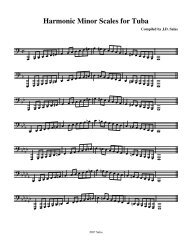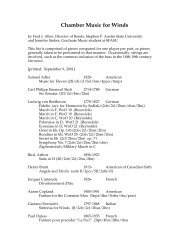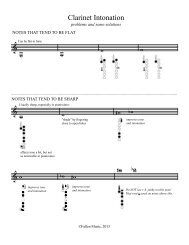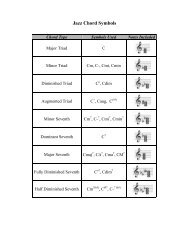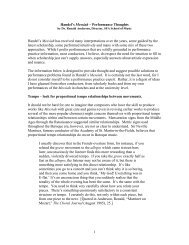Trombone Rep - History of the Trombone - Timeline 1 (EatonMensch ...
Trombone Rep - History of the Trombone - Timeline 1 (EatonMensch ...
Trombone Rep - History of the Trombone - Timeline 1 (EatonMensch ...
Create successful ePaper yourself
Turn your PDF publications into a flip-book with our unique Google optimized e-Paper software.
<strong>History</strong> <strong>of</strong> <strong>the</strong> <strong>Trombone</strong><br />
P. 19<br />
Date Information Citation<br />
1800-1870<br />
A.D.<br />
"The functions <strong>of</strong> trombones in orchestration show some expansion during <strong>the</strong> second quarter<br />
<strong>of</strong> <strong>the</strong> nineteenth century. French and Italian composers wrote largely for three tenor<br />
trombones, and continued to place <strong>the</strong> harmony in close position; <strong>the</strong> Germans remained true<br />
to <strong>the</strong> old group <strong>of</strong> alto, tenor, and bass, spreading <strong>the</strong> parts over a ra<strong>the</strong>r wide compass. That<br />
trombones should add <strong>the</strong> weight <strong>of</strong> <strong>the</strong>ir tone to any loud chord or tutti was now more or less<br />
a convention. The value <strong>of</strong> <strong>the</strong> effect <strong>of</strong> s<strong>of</strong>t harmony on trombones was appreciated by, and<br />
Carse p. 249-50<br />
exploited by, practically all composers during <strong>the</strong> period immediately following <strong>the</strong> time <strong>of</strong><br />
Weber. The idea <strong>of</strong> giving trombones independent <strong>the</strong>matic matter, was as yet undeveloped,<br />
yet it was in this period that composers began to treat <strong>the</strong> trombone as an independent voice.<br />
Great strides in this direction were made by Berlioz and Wagner before <strong>the</strong> mid-century has<br />
passed, but <strong>the</strong> most subsstantial advance was still to come, and belongs to <strong>the</strong> third quarter<br />
<strong>of</strong> <strong>the</strong> nineteenth century."<br />
1800s A.D. "<strong>Trombone</strong> parts already foreshadow <strong>the</strong> now conventional grouping in three."<br />
"John Hyde and a maker Woodham claimed to have invented this 'Chromatic Trumpet' which<br />
Carse p. 20<br />
1800s A.D. became under <strong>the</strong> name 'Slide Trumpet' a celebrated orchestral and solo instrument in<br />
England through much <strong>of</strong> <strong>the</strong> nineteenth century."<br />
Baines p. 182<br />
1800s A.D.<br />
1800s A.D.<br />
1800s A.D.<br />
The trombone (<strong>of</strong> <strong>the</strong> 19th century) has not changed much from descriptions <strong>of</strong> trombones<br />
from <strong>the</strong> 16th and 17th centuries.<br />
French and Italian orchestral composers usually wrote for just tenor trombone while German<br />
orchestral composers wrote for alto, tenor, and bass trombone in F.<br />
"Some military band trombones were made with <strong>the</strong> bell pipe coiled in a loop so that <strong>the</strong><br />
sound was projected back over <strong>the</strong>r player's shoulder, and in o<strong>the</strong>rs <strong>the</strong> bell itself was<br />
replaced by a grotesque animal mask…"<br />
Carse p. 218<br />
Carse p. 218, 249<br />
Bate p. 54<br />
1800s A.D.<br />
Some French trombones were equiped with a "mushroom valve" in <strong>the</strong> bottom bow <strong>of</strong> <strong>the</strong><br />
slide which "could be opened by a slight pressure against <strong>the</strong> floor."<br />
Bate p. 86<br />
1800s A.D. The valve trombone is used in marching or mounted military bands. Bate p. 64<br />
1800s A.D. Military bands create a lasting revival <strong>of</strong> <strong>the</strong> use <strong>of</strong> trombones. Bate p. 148



![Finale 2008 - [Whole Tone Scales - Tuba.MUS]](https://img.yumpu.com/50937649/1/190x245/finale-2008-whole-tone-scales-tubamus.jpg?quality=85)

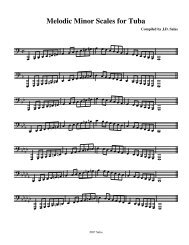
![Finale 2008 - [Chromatic Scales - Tuba.MUS]](https://img.yumpu.com/36500491/1/190x245/finale-2008-chromatic-scales-tubamus.jpg?quality=85)
